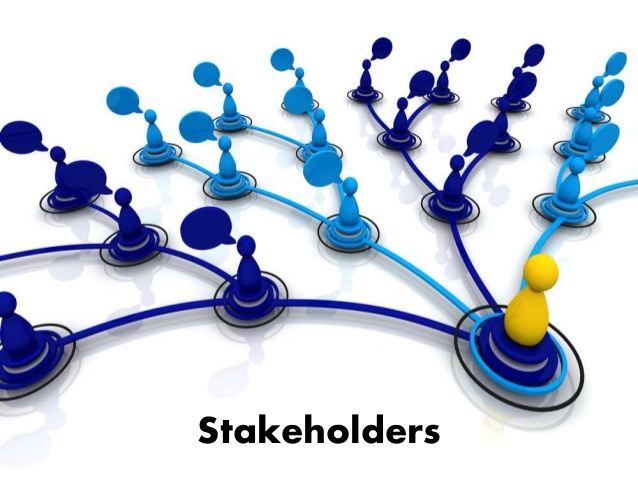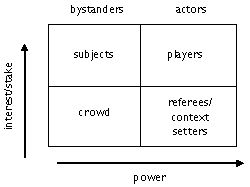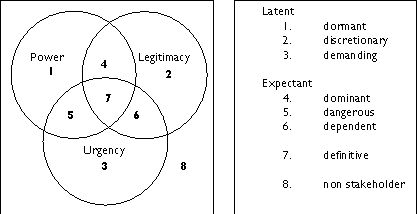Stakeholder Analysis

Who is a stakeholder? An introduction to stakeholder analysis.
In some of the broader definitions of stakeholders a great many groups and individuals are identified as having an interest in a given issue. Given limited resources, however, it may not be possible for them all to be included in a process of engagement. Some way of distinguishing between stakeholders thus has to be found. Mitchell et al refer to this as ‘stakeholder salience’ and describe it as the groups and individuals to which one must ‘pay attention’. Grimble and Chan (1995, p. 114) , define stakeholder analysis as ‘an approach and procedure for gaining an understanding of a system by means of identifying the key actors or stakeholders in the system, and assessing their respective interests in that system’. Also, if the issue is to enhance adaptive capacity, key stakeholders should be considered those who act, are actors, in this process (O., Paz, .).
A number of different approaches are available to try to distinguish between stakeholders. Some are simple matrices e.g. Van der Heijden (1996) quoted in van der Werff, (2001).

In this example van der Heijden divides stakeholders in terms of their power and interest or stake in the issue at hand. Thus stakeholders can be termed as ‘players’ if they possess power and have a stake or large interest in the issue. Stakeholders with an interest but no power are termed ‘subjects’. These groups and individuals are affected by the issue but have no power to influence the debate. The ‘crowd’ is made up of stakeholders without power or interest. These groups are sometimes considered to be unaffected and thus are not engaged in the debate. The ‘referees’ have some power but are unaffected themselves. These groups such as journalists, researchers and politicians are engaged in the debate and are sometimes referred to as ‘external’ stakeholders.
Mitchell et al. (1997) proposed that classes of stakeholders can be identified by their possession of either 1. power to influence the firm, 2. the legitimacy of the relationship with the firm 3. the urgency of the claim. Salience is the term they used to describe the degree to which managers give priority to competing stakeholder claims. Stakeholder salience will be high where all three of the stakeholder attributes are perceived as present. A worked example of this approach can be found in Mikalsen et al (2001) in determining key stakeholders in fisheries management.

The stakeholders in the low salience classes (areas 1, 2, 3) are termed ‘latent’. With two or more attributes the stakeholders are termed as ‘expectant’ and the stakeholders are said to have moved from a passive to an active stance. The level of engagement is correspondingly higher. Any stakeholder can become definitive, (possessing all three attributes) by acquiring the missing attributes. This approach provides a map of stakeholders which helps in visualising what changes might lead a stakeholder to acquire a missing attribute and thus gain more salience. It also shows the dynamic nature of stakeholder relationships. Stakeholders change in salience from issue to issue, from time to time. For the map to work the attributes are said to be absent or present when in fact each attribute is present as part of a continuum from low to high. Mikalsen et al, (2001) in their worked example for the fishing industry point out that this approach assumes that stakeholders are aware of the attributes they possess. In reality, some stakeholders are often not aware that they possess an attribute and so do not use it or need to be pushed to use it.
Simpler analyses can be used in order to think through which stakeholders need to be engaged in a given process. Hamdi, 2002 (pers.com) recommends the use of a simple table. This can be adapted in order to take into account the needs of specific projects. Columns could be added to include the relative organisation of the different groups, or their decision-making power.

From these approaches we can define primary stakeholders as those groups and individuals that will ultimately be affected if the process of adaptation to climate change is not developed. These individuals and groups, often the most vulnerable, are the most involved and concerned in the process and are already acting, either adapting or maladapting, to climatic risk or climatic events. Secondary stakeholders are the individuals and groups that are not directly involved but can influence the outcomes of the designed strategies or policies, and that could be affected indirectly by climate change impacts.
Related Pages
Introduction to Stakeholder Analysis
Planning Stakeholder Engagement
(0) Comments
There is no content